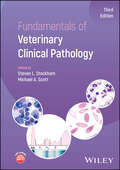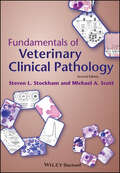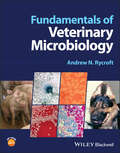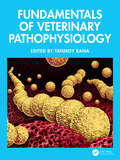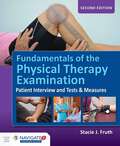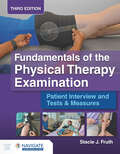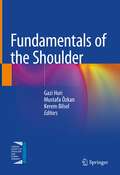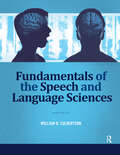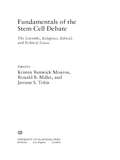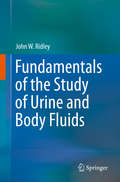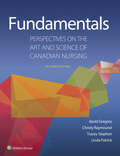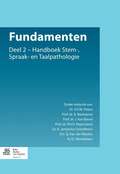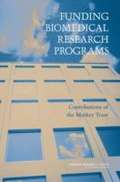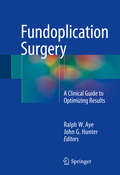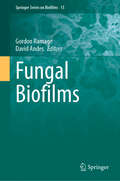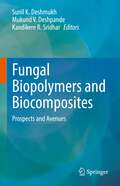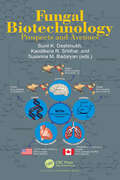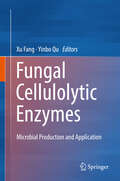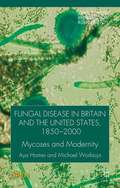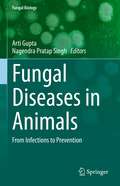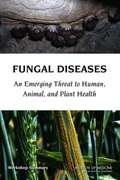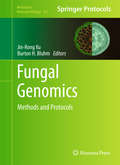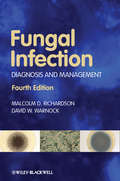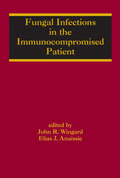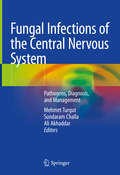- Table View
- List View
Fundamentals of Veterinary Clinical Pathology
by Steven L. Stockham Michael A. ScottProvides the information needed to interpret clinical laboratory assays of domestic mammals Fundamentals of Veterinary Clinical Pathology, Third Edition presents thoroughly updated and detailed information to promote appropriate clinical laboratory testing and interpretation of test results for common domestic mammals. Presented in an easy-to-use outline format complemented by many relevant tables and illustrations, the book is now in full color. This evidence-based guide synthesizes the laboratory principles, physiology, assays, analytical concepts, pathophysiologic states, and pathophysiologic processes relevant to detecting, evaluating, and understanding disorders in dogs, cats, horses, cattle, and camelids. Content additions include two entirely new chapters on synovial and cerebrospinal fluid analysis, as well as expanded sections on blood typing and crossmatching, viscoelastic testing, protein electrophoresis, positive acute-phase proteins, mixed acid-base disorders, vitamin D analysis, analytical and biological variation, blood smear evaluation, and more. New clinical tests and methods, useful data patterns, and additional disorders and pathologic processes are integrated throughout. Providing a conceptual understanding applicable to many species and serving as a valuable clinical reference, Fundamentals of Veterinary Clinical Pathology: Uses consistent terminology and chapter organization featuring separate sections for physiologic concepts, analytical methods, and interpretation of resultsProvides pathophysiologic explanations of laboratory abnormalitiesAllows easy access to information on disorders and conditions, grouping them by common mechanisms or processes and ordering them in parallel across interpretive tables and textFeatures a wealth of high-quality illustrations and photomicrographs throughout the text Includes extensive referencing on the companion website to support statements and provide direction for further reading Fundamentals of Veterinary Clinical Pathology, Third Edition is an excellent textbook for veterinary students taking clinical pathology courses, as well as a valuable resource for clinical and anatomic pathology residents, medicine and surgery residents, and practicing veterinarians.
Fundamentals of Veterinary Clinical Pathology (Second Edition)
by Steven L. Stockham Michael A. ScottThis book provides in-depth information about common clinical laboratory assays that are used to evaluate domestic mammals, including what assays measure, sample or assay conditions that affect results, and what results indicate about the physiologic or pathologic state of a patient. Whenever possible, diseases and conditions are grouped by common mechanisms or processes to promote a conceptual understanding of laboratory data that can be generally applied across many species. New to the second edition are additional disorders, diagnostic tests, illustrations, images, references, and pathophysiologic explanations. This text has proven valuable to students and veterinarians wanting a fundamental understanding of veterinary clinical pathology.
Fundamentals of Veterinary Microbiology
by Andrew N. RycroftA compact and accessible guidebook exploring current understanding of common bacterial and fungal pathogens of animals. Fundamentals of Veterinary Microbiology brings together knowledge and understanding of the bacterial pathogens of animals from disease signs and diagnostic methods to the molecular basis of the host pathogen interaction. A small but focused book, it enables the reader to access important information during diagnosis and treatment in a clinically relevant way. Suitable as a companion for study on the subject and for professional use, the author focuses on the more clinically common diseases at the general and first-referral level. Divided into three sections, the first covers the basics of bacterial microbiology such as structure, growth and genetics. The second examines the commonly encountered bacterial pathogens, with emphasis on current understanding of the cellular and molecular basis of infection and immunity. The third section explores the current state of knowledge of those fungi involved in infection of animals. Specific topics covered in Fundamentals of Veterinary Microbiology include: Nutrition, sterilization, and disinfection of bacteria, bacterial genes and gene transfer, pathogenicity and host response, and vaccination Antimicrobials (action, dynamics, and resistance), typing and identification of pathogens, fungi as agents of disease, Salmonella and E. coli in animal disease and public health. Pathogens transmitted by vectors such as Borrelia, those of endogenous origin such as Clostridium and Pasteurella and those able to spread widely such as Leptospira, Mycobacterium and Chlamydia. Fungal pathogens causing superficial, subcutaneous and systemic mycoses. Fundamentals of Veterinary Microbiology is an essential resource for veterinary students, veterinary nurses, and veterinary practitioners worldwide, allowing them to quickly establish a foundation of knowledge of bacterial pathogens based on clear understanding gained from studies over recent decades.
Fundamentals of Veterinary Pathophysiology
by Tanmoy RanaThis textbook for advanced graduate and postgraduate veterinary students provides a comprehensive overview of clinical physiology with a focus on its application in diagnosing and managing various disorders in animals. Fundamentals of Veterinary Pathophysiology is divided into two main sections. The first section introduces the general aspects of clinical physiology, covering intricate mechanisms such as temperature regulation, animal nutrition, and biological oxidation. It delves into topics like enzymatic regulation, metabolism, the physiology of membranes, body water, and ionic regulation. The section concludes by providing essential insights into the fundamentals of important physiological disorders and dysfunctions. The second section delves into the clinical physiology of disorders within various body systems. It covers digestive disorders in both monogastric and ruminant animals, cardiovascular and respiratory disorders, hematological disorders, neurological disorders, endocrinal disorders, urinary disorders, and lymphatic disorders. Finally, the book concludes with an in-depth examination of the clinical physiology of eye, ear, skin, male reproductive and female reproductive disorders.Key Features Introduces fundamental concepts of clinical animal physiology for advanced graduate and postgraduate veterinary students Emphasizes the practical application of clinical physiology in the diagnosis and managing of animal disorders Provides understanding of intricate physiological mechanisms including temperature regulation, enzymatic regulation and metabolic processes Addresses specific physiological disorders, offering insights into clinical aspects related to digestive, cardiovascular, respiratory and neurological systems Discusses clinical physiology associated with disorders of the eye, ear, skin and reproductive system
Fundamentals of the Physical Therapy Examination: Patient Interview and Tests & Measures
by Stacie J. FruthFundamentals of the Physical Therapy Examination: Patient Interview and Tests & Measures, Second Edition provides physical therapy students and clinicians with the necessary tools to determine what questions to ask and what tests and measures to perform during a patient exam. This text utilizes a fundamental, step-by-step approach to the subjective and objective portions of the examination process for a broad spectrum of patients. This edition has been updated and revised to reflect the new APTA Guide 3.0, and the Second Edition also includes new and extensive coverage of goniometry and manual muscle testing techniques with more than 300 new photographs.
Fundamentals of the Physical Therapy Examination: Patient Interview and Tests & Measures
by Stacie J. FruthFundamentals of the Physical Therapy Examination: Patient Interview and Tests & Measures, Third Edition provides physical therapy students and clinicians with the fundamental, step-by-step information needed to determine questions to ask and tests and measures to perform during a patient exam.
Fundamentals of the Shoulder
by Gazi Huri Mustafa Özkan Kerem BilselThis book comprehensively covers both basic and clinical aspects of the shoulder, from its anatomy and biomechanics, to the diagnosis and treatment of a broad range of shoulder disorders. Designed as a practical and richly illustrated reference guide, it provides the reader with the essentials needed to evaluate and treat shoulder injuries, including radiologic assessments, rehabilitative techniques and surgical procedures (both open and arthroscopic). It includes extensive coverage of the anatomy and pathology, while clinical topics covered include fractures around the shoulder joint, sport injuries and arthroplasty. Written by an international team of experts, who share tips, pearls and pitfalls, as well as best practices from their own experience, the book will be of interest to orthopedic surgeons, physical therapists, rehabilitation specialists and biomechanists alike.
Fundamentals of the Speech and Language Sciences
by William CulbertsonFor a strong foundation upon which to build their futures, students in communication sciences and disorders programs need the best, most up-to-date information available to guide them. To this end, Fundamentals of the Speech and Language Sciences provides a thorough understanding of the core concepts in speech and language while maintaining a readable, engaging tone. Students will be exposed to the fundamentals of acoustics, respiratory science, voice production, acoustic phonetics, and sound spectrography. Language representation and motor programming as they pertain to the dynamic process of speech communication are also explored, as are the fundamentals of speech perception and instrumentation. To give students context, side bars feature the stories of seminal scientists and scholars and their contributions to the topics being discussed. This text benefits from Dr. William Culbertson’s nearly three decades of experience in teaching, as well as another decade of experience as a clinical speech-language pathologist. That experience has honed his ability to clearly communicate these crucial topics in a way that students will understand.Topics covered: The scientific method and various types of research used to study the normal aspects of human speech and hearing The basics of physics as they pertain to energy, motion, displacement, force, and pressure and their relationship to speech production The process of respiration as it pertains to gas compression, speech valving, driving pressure, impedance, and flow Voice onset, modes of vocal vibration, pitch adjustment, volume and quality The process of dynamic interaction representation at the cortical and subcortical levels of the five basic speech processes: respiration, phonation, articulation, resonance, and prosody Undergraduate students in communication sciences and disorders programs, as well as the related programs of music (voice), special education, and speech communication, will value Fundamentals of the Speech and Language Sciences as the formative text for their understanding of the speech and language sciences.
Fundamentals of the Stem Cell Debate
by Ronald Miller Kristen Renwick Monroe Jerome TobisFew recent advances in science have generated as much excitement and controversy as human embryonic stem cells. The potential of these cells to replace diseased or damaged cells in virtually every tissue of the body heralds the advent of an extraordinary new field of medicine. Controversy arises, however, because current techniques required to harvest stem cells involve the destruction of the human blastocyst. This even-handed, lucidly written volume is an essential tool for understanding the complex issues--scientific, religious, ethical, and political--that currently fuel public debate about stem cell research. One of the few books to provide a comprehensive overview for a wide audience, the volume brings together leading scientists, ethicists, political scientists, and doctors to explain this new scientific development and explore its ramifications.
Fundamentals of the Study of Urine and Body Fluids
by John W. RidleyThis volume provides the essential theory as well as practice for the study of urine and body fluids other than urine. It is a concise compendium of information both of a practical as well as a clinical resource for understanding conditions of patients with whom the laboratory analyst has contact. It informs the reader not only of the how to perform certain tests but also of the why these tests are clinically important and therefore helps in obtaining the best clinical data possible.
Fundamentals: Perspectives on the Art and Science of Canadian Nursing
by David Gregory Tracey Stephens Christy Raymond-Seniuk Linda PatrickPublisher's Note: Products purchased from 3rd Party sellers are not guaranteed by the Publisher for quality, authenticity, or access to any online entitlements included with the product. Master the unique, multi-faceted role of the Canadian nurse. Confidently embark on a lifelong learning journey and prepare for the daily realities of Canadian nursing practice this with comprehensive, Canadian-focused text. Developed specifically for your needs by talented Canadian students, practicing nurses, scholars, and educators, Fundamentals: Perspectives on the Art and Science of Canadian Nursing, 2nd Edition, delivers an integrated understanding of nursing fundamentals through a continuum that guides you from one chapter to the next and from learning to understanding. New! Inter-Professional Practice helps you achieve positive patient outcomes through effective collaboration with the healthcare team. New! Diversity Considerations alert you to important patient care considerations related to culture, sexuality, gender, economics, visible minorities, and religious beliefs. New! NCLEX®-style questions at the end of each chapter test your retention and ready you for success on your exams. Revised! Skills chapters familiarize you with a wide variety of advanced skills to broaden your clinical capabilities. Enhanced focus on LGBTQ-related considerations, demographic shifts in Canadian society, end-of-life/palliative care, substance abuse crises, and refugee communities helps you ensure confident care across diverse Canadian populations. Case Studies place chapter content in a realistic context for the most practical understanding. Think Boxes encourage critical thinking and challenge you to apply your knowledge to different situations. Through the Eyes features familiarize you with patients’ perspectives to help you provide thoughtful and effective care interventions. Research equips you with the latest and most relevant Canadian healthcare findings based on clinical evidence. Critical Thinking Case Scenarios strengthen your clinical focus and critical thinking through real-life situations.
Fundamenten: Deel 2 - Handboek Stem-, Spraak- en Taalpathologie
by H.F.M Peters R. Bastiaanse J. Borsel P.H.O. Dejonckere K. Jansonius-Schultheiss Sj. Meulen B.J.E. MondelaersHet Handboek Stem-Spraak-Taalpathologie verscheen tussen 1997 en 2007 gefaseerd in losse afleveringen. Daarin werd alle kennis op het gebied van de stem-, spraak- en taalpathologie vanuit verschillende disciplines samengebracht. Het Handboek is bestemd voor iedereen die klinisch-praktisch of meer theoretisch is geïnteresseerd, of vanuit een ander vakgebied hiermee in aanraking komt. Voor logopedisten, artsen, linguïsten, spraak- en taalpathologen, audiologen, pedagogen en psychologen in Nederland en België is het Handboek een onmisbare vraagbaak.Deel 2 bevat basiskennis over informatieverwerkingsprocessen: de cognitieve architectuur van spraak en taal; basiskennis over hoe taal in de menselijke hersenen is verankerd: de neurale architectuur; en de basiskennis over het spraakproductieproces waarvoor spraakorganen en gehoor nodig zijn: de perifere architectuur.
Funding Biomedical Research Programs: Contributions of the Markey Trust (2006)
by National Research Council of the National AcademiesDuring an interval of 15 years, the Lucille P. Markey Charitable Trust spent over $500 million on four programs in the basic biomedical sciences that support the education and research of graduate students, postdoctoral fellows, junior faculty, and senior researchers. The Markey Trust asked the NRC to evaluate these programs with two questions in mind: “Were these funds well spent?” and “What can others in the biomedical and philanthropic communities learn from the programs of the Markey Trust, both as an approach to funding biomedical research and as a model of philanthropy?” One of five resulting reports, this volume examines the Research Program Grants, which awarded $323 million to support investigators with a major commitment to the life sciences and to assist in the establishment, reorganization, or expansion of significant biomedical research centers or programs. Using information from Markey archives, materials from grant recipients, and site visits to a sample of institutional grant recipients, the authoring committee describes the impact that Markey grants made on the centers and programs funded by these grants, along with the unique aspects of the Markey approach to funding that may be applicable to other funders of biomedical research programs.
Fundoplication Surgery
by Ralph W. Aye John G. HunterThis book is intended for surgeons wanting to take their antireflux practice to an advanced level. It focuses on what experts do in real life, highlights pitfalls in skillful patient selection and fundoplication surgical technique, and addresses how to handle the "curve balls". It also provides recommendations on obtaining high patient satisfaction and building relationships with referring physicians. It is intended as an "expert" level manual to help readers move to the next level in their practices. From patient assessment and selection, anticipation of perioperative challenges, intraoperative problem-solving and technique, and postoperative management of side-effects, to reducing long-term recurrence rates and resumption of antisecretory medication, these expert authors dig deep to share the pearls of wisdom that make the difference between the average surgeon and the expert. Written by experts in the field, Fundoplication Surgery: A Clinical Guide to OptimizingResults confronts the issues that have hindered the broader use of fundoplication nationally and is a valuable resource and reference guide for addressing ambiguous symptoms and test results in one's practice.
Fungal Biofilms (Springer Series on Biofilms #15)
by Gordon Ramage David AndesThis book provides a comprehensive and up-to-date compendium of critical information for those working in the field of fungal biofilms, and those entering the field. The WHO has published a list of critical high-priority fungal pathogens, many of which are capable of forming biofilms. The editors have brought together a team of world experts to impart their knowledge of specific elements of fungal biofilm biology and their clinical underpinning. The book covers critical areas of state-of-the-art research that are shaping the direction of travel within the biofilm research community. It focuses on the basic biology of how biofilms are formed and controlled, through applied areas of research where we can effectively manage these complex infections.
Fungal Biopolymers and Biocomposites: Prospects and Avenues
by Sunil K. Deshmukh Mukund V. Deshpande Kandikere R. SridharThe book covers an overview of fungal polymers, fungal mycelial biomass, and their applications besides providing a detailed account of various opportunities. This book also includes information on developments in mycotechnology related to fashion, furnishing, construction, packaging, mycelial-based bricks, construction binder, cementing materials, and so on. Other aspects include the value of chitin, chitosan, hydrophobins, lignocellulosic composites, oil recovery, biosurfactants and bioemulsifiers, nanofibers from pullulan, exopolymeric substances, bioresins, and biocomposites. Additional topics covered in the book include self-healing fungal concrete (which could help to build repairs) and recipe to inhibit fruit body formation, for living fungal biomaterial manufacture. There is no comprehensive book other than – some reviews, which addressed very brief historical developments and preliminary aspects of fungal biopolymers. Written by experts in their field from countries like Australia, India, USA, Germany, Turkey, Philippines, Oman, Belgium, Italy, Egypt, Brazil, and the United Kingdom, the chapters discuss at length applications of filamentous fungi in sustainable industrial pursuits and industrial developments with environmental safety. This book will be useful for students, teachers, researchers, and scientists in botany, microbiology, life sciences, biotechnology, agriculture and, industries that extensively use fungi for the production of value-added products.
Fungal Biotechnology: Prospects and Avenues (Progress in Mycological Research)
by Sunil K. DeshmukhTraditional studies in mycology mainly deal with damage caused by fungi, for instance, diseases of plants, animal ailments, air-borne pathogens, decomposition of wood and production of mycotoxins in food. Applied mycology focuses on the fermentation of foods (flours, bakery products, cheese and others) and production of fermented products (wine, beer and spirit). Further value-added approaches show the significance of fungi in the production of bioactive metabolites and pharmaceuticals used in the treatment of human diseases, including cancer, and plant diseases (e.g. pest control). Due to a dependence on fossil resources, production of bio-renewable merchandise gained importance and fungi serve as potential biological agents in sustaining global economy. Recent developments in mycology revealed their significance in the fields of advanced research, in particular building materials, packaging resources, electronic devises and leather-like goods. In addition, fungi possess several qualities to degrade non-biodegradable compounds in the ecosystem and assist in sustainable waste bioremediation. This book covers the current biotechnological advances and bio-prospect potential of fungi. Fungal biopolymers possess various applications, including prebiotics, therapeutics, immunoceuticals, drug-discovery and drug-delivery. Fungal bioactive metabolites have several implications beyond antibiotics, such as volatiles, biofuels, nematicides and pigments. They also serve as prospective tools in the production of nanoparticles of medicinal, nutritional and industrial significance. In view of environmental protection, fungal activity and products aid in bioremediation via degradation of xenobiotics and solid wastes. Fungi can produce agriculturally compatible metabolites to enhance plant production. Knowledge on fungal genomics facilitates the gene manipulation towards biotechnological applications (disease diagnosis, pathogen detection, gene expression and mutualistic interactions). This book addresses the application of fungi in different areas and serves as a potential knowledge bank for graduates, post-graduates and researchers contemplating fungal applications.
Fungal Cellulolytic Enzymes: Microbial Production And Application
by Xu Fang Yinbo QuThe book provides an overview of the current knowledge on cellulolytic enzymes and their applications. It summarizes the mechanisms of synthesis and hydrolysis of cellulolytic enzymes, industrial fungal strains, genetic engineering of fungal strains and application of cellulolytic enzymes. This book will be a useful reference for researchers and bioengineering experts engaged in lignocelluloses biodegradation, biomass utilization, enzyme production and fungal molecular biology.
Fungal Disease in Britain and the United States 1850�2000
by Aya Homei Michael WorboysThis book is open access under a CC BY license. The grand narrative of twentieth-century medicine is the conquering of acute infectious diseases and the rise in chronic, degenerative diseases. The history of fungal infections does not fit this picture; indeed, it runs against it - this book charts the path of fungal infections from the mid nineteenth century to the dawn of the twenty-first century, both in Britain and the United States. It examines how fungal infections became more prevalent and serious over the century, a rise that was linked to the increased incidence of chronic diseases and to social, technological and medical 'progress'. In 1900, conditions such as ringworm, athlete's foot and thrush were minor, external and mostly chronic conditions - irritating, but mostly self-limiting. In the subsequent decades, these infections remained very common, but were better controlled by antifungal drugs. However, by the year 2000 doctors were faced by a growing number of serious and life-threatening fungal infections, such as invasive aspergillosis and systemic candidiasis. These infections principally affect patients who have benefited from medical advances, such as antibiotic treatment and transplantation, and those with immuno-compromised conditions.
Fungal Diseases in Animals: From Infections to Prevention (Fungal Biology)
by Arti Gupta Nagendra Pratap SinghThe importance of fungal infections in both human and animals has increased over the last few decades. This book presents an overview of the different categories of fungal infections that can be encountered in animals (including lower vertebrates) originating from environmental sources with or without transmission to humans. In addition, the endemic infections with indirect transmission from the environment, the zoophilic fungal pathogens with near-direct transmission, the zoonotic fungi that can be directly transmitted from animals to humans, mycotoxicoses and antifungal resistance in animals will also be discussed. This book includes case studies and reviews the current state of knowledge on the mechanism of fungal attraction, recognition, infection, extracellular hydrolytic enzymes and pathogenesis of nematophagous fungi. The book also covers diagnostics, fungal formulations, as well as prevention methods. It discusses strategies to access the fungal pathogen groups, metagenomic analyses, genomics, secretomics, metabolomics, proteomics and transcriptomics. In addition, pathogen description, understanding, distribution and recent research results are provided.
Fungal Diseases: Workshop Summary
by The National Academy of SciencesScientists from biological, medical, and environmental fields look both at specific pathogens and hosts and at the role fungus plays in the world and the economy generally. The 80-page workshop overview is followed by 21 contributed papers on such topics as the emergence of Cryptococcus gattii in British Columbia and the Pacific Northwest, surveillance for emerging diseases in wildlife, putting yellow rust into the perspective of the increased risk of global wheat rust pandemics, similarities and differences in fungal pathogenesis in plants and animals, the effect of the trade-mediated spread of amphibian chytrid on amphibian conservation, and the pan-European distribution of the bat white-nose syndrome fungus. The workshop was held in December 2010, in Washington, DC. Annotation ©2012 Book News, Inc. , Portland, OR (booknews. com)
Fungal Genomics
by Burton H. Bluhm Jin-Rong XuHaving experienced unprecedented growth since the turn of the millennium, the dramatic expansion of resources and techniques in fungal genomics is poised to fundamentally redefine the study of fungal biology. In Fungal Genomics: Methods and Protocols, expert researchers explore the three most likely fronts upon which the field will advance: the sequencing of more and more fungal genomes, the mining of sequenced genomes for useful information, and most importantly, the use of genomics sequences to provide a foundation for powerful techniques to explain biological processes. Much of the book is dedicated to explaining established and emerging genomics-based technologies in filamentous fungi, including gene expression profiling techniques, techniques for fungal proteomics as well as various case studies that could be adapted to a wide range of fungi. Written in the highly successful Methods in Molecular BiologyTM series format, protocol chapters include brief introductions to their respective topics, lists of the necessary materials and reagents, step-by-step laboratory protocols, and key unpublished tips, potential pitfalls, common mistakes, and special considerations based on the unique experiences of the contributors. Authoritative and cutting-edge, Fungal Genomics: Methods and Protocols provides fungal biologists at any stage of their careers a user-friendly resource for fungal genomics, especially as readers branch out into unfamiliar but exciting new areas of study.
Fungal Infection
by David W. Warnock Malcolm D. RichardsonFungal Infection: Diagnosis and Management, 4th Edition is a concise and up-to-date guide to the clinical manifestations, laboratory diagnosis and management of superficial, subcutaneous and systemic fungal infections.This highly acclaimed book has been extensively revised and updated throughout to ensure all drug and dosage recommendations are accurate and in agreement with current guidelines. A new chapter on infections caused by Pneumocystis jirovecii has been added. The book has been designed to enable rapid information retrieval and to help clinicians make informed decisions about diagnosis and patient management. Each chapter concludes with a list of recent key publications which have been carefully selected to facilitate efficient access to further information on specific aspects of fungal infections.Clinical microbiologists, infectious disease specialists, as well as dermatologists, hematologists and oncologists, can depend on this contemporary text for authoritative information and the background necessary to understand fungal infections.
Fungal Infections in the Immunocompromised Patient
by John R. Wingard Elias J. AnaissieUnlike any other source on the subject, this reference provides an up-to-date account of fungal syndromes in immunocompromised patients and provides expert descriptions of their clinical manifestations and settings in which they cause illness-covering the pros and cons of current and emerging diagnostic measures, techniques to incorporate new diagn
Fungal Infections of the Central Nervous System: Pathogens, Diagnosis, and Management
by Mehmet Turgut Ali Akhaddar Sundaram ChallaThis book provides comprehensive information on fungal infections of the central nervous system (CNS). Fungal infections are still a major public health challenge for most of the developing world and even for developed countries due to the rising numbers of immune compromised patients, refugee movements, and international travel. Although fungal infections involving the CNS are not particularly common, when they do occur, the results can be devastating in spite of recent advances and currently available therapies. Further, over the past several years, the incidence of these infections has seen a steep rise among immunodeficient patients. In this context, aggressive surgery remains the mainstay of management, but conservative antifungal drug treatment complemented by aggressive surgical debridement may be necessary. Yet the optimal management approach to fungal infections of the CNS remains controversial, owing to the limited individual experience and the variable clinical course of the conditions. Addressing that problem, this comprehensive book offers the ideal resource for neurosurgeons, neurologists and other specialists working with infectious diseases.
